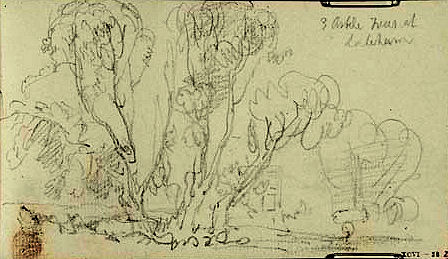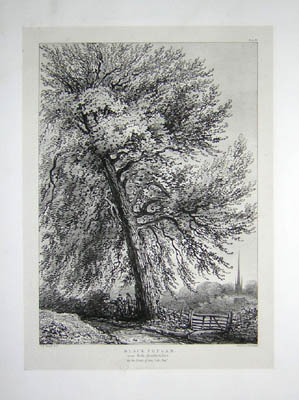|
The Black Poplars of the Wilstone Area near Tring |
|
|
If you visit the village of Wilstone, near Tring, and wander through the low-lying fields of the area you will notice that the hedgerows are dominated by a distinctive species of tree which you might not immediately recognise. It is the black poplar. Outside the parish hall there is a notice giving details of the Black Poplar Trail - and there is an excellent leaflet available online (pdf). So what is special about these trees and what does it tell us about the local history of the area? |
Black Poplar on Wilstone Great Farm |
|||||||||||||||
| The first thing to note is
that they only grow in very damp areas and in many cases the
hedgerows are adjacent to a water-filled ditch. Travel only a
mile onto the better drained edge of the Chiltern Hills and
the trees vanish entirely. A recent survey suggested that
there were about 2,500 of the trees in the Vale of Aylesbury,
representing a third of the total UK population. So while
they are common in the area they are nationally a
conservation priority. There is another important feature. The black poplar trees are either male (red catkins) or female (clouds of white fluffy windborne seeds) and all the trees in the Wilstone area are male. The absence of any female trees suggests that the trees were deliberately planted in the hedgerows as cuttings, in large numbers, almost certainly as a cash crop, the oldest ones possibly being 200 years old, with many of the older trees showing evidence of being pollarded. In the past they clearly had significant commercial uses as the Small Woodland Owner's Group web site reports:
So far there seems to be very little contemporary historical evidence, as to how they were used in the Wilstone area but I am just being to put William Brown's 1850s account book online and have so far identified some entries which may through a little light on the commercial use of poplar trees at Wilstone. --------- James Grout rented Tring Park and he also had control of a farm in Wilstone which was leased to William Greening. Payments to Drayton Beauchamps suggest some holding in that parish and the farm may have straddled the county boundary. The following entries in the account book appear to relate to timber grown on this farm.
James Grout's Account - Folio 41 - expenditure
James Grout's Account - Folio 41 - receipts
Executors of James Grout's Account - Folio 276 - expenditure
Executors of James Grout's Account - Folio 276 - receipts What is an "Arbele Tree" The word is omitted from most printed dictionaries, but the online Oxford Dictionary provides a brief definition., with notes on the etymology and examples of its use.
But is this correct in the context described above, where arbele are being sold from a farm where black poplar is a cash crop. I suspect that historically the name arbele was the name for any poplar tree. The starting point is to consider the biology of poplar trees and the likely etymology.
A search of adverts in the Bucks Herald in the 19th century (such as this example from January 1850) shows that "arbele" trees were advertised (but never "poplar" or "black poplar" trees) even when the sales involved timber from areas where black poplar was common. Sales in other parts of England mentioned black poplar, but I could find no examples when a sale involved the sale of both black poplar and arbele. It therefore seems very likely that the term "arbele" was used in the Vale of Aylesbury either for any kind of poplar, or specifically for the black poplar. Provisional identification of the people mentioned, Amsden: By this date John Amsden had moved to Park Street, Tring, and become a coal merchant. While he could have purchased the trees for use as logs, the use of the word "timber" suggests a more serious use, where he perhaps sold the timber on. Brown: Presumably William Brown, having arranged the sale of the timber, kept the lop and top for firewood, and made an appropriate payment into the account. Greening: In 1851 William Greening was a farmer of 150 acres in Wilstone, and was James Grout's tenant. Grout: James Grout was the tenant of Tring Park and was William Greening's landlord. Harris: Could be Joseph Harris, a builder employing 14 men on the High Street, Berkhamsted. As black poplar wood is said to be good for flooring in houses where paraffin lamps are used, a house builder in the 1850s could well want to use arbele wood for the floors. The pollarded poles could also be used for scaffolding. Osborn: A family of carpenters living in Drayton Beauchamp - they could have felled the trees Newman: Master wheelwright living at Wilstone. The wood has properties he could find valuable. While these account entries do not reveal exactly what the black poplar was being used for it seems that the trees in the area were being considered as a cash crop in the 1850s. For this reason I will be looking to see if there are any other references in William Brown's Account Book, or elsewhere, which refer to the harvesting of poplars or arbele in the Vale of Aylesbury. If you know of any other references please let me know. |
||||||||||||||||
Anthony reported that Turner had a sketch showing Arbele Trees.
According to OxfordDictionaries the White Poplar was introduced to England from the Netherlands in the late 16th century. The Oxford English Dictionary gives several 14th and 15th century references - apparently before the White Poplar was introduced - so if these references were to native trees it must be some other species of Poplar. One quote from 1597 clearly links the name White Poplar to Arbele - but a 1830 quote lists Arbele as a East Anglian dialect word for the Asp (Aspen). What I am suggesting is that in 1850 Arbele was a Vale of Aylesbury word for Black Poplar, or was used in the area for any species of Poplar tree. One has to be careful about the evidence from Turner's sketch. The trees shown may well be White Poplar and Turner called the Arbele - but can we be sure he meant the specific species - or was using it in a wider sense. I did a google search for other works by Turner for other pictures with any kind of poplars shown - and found none apart from the example above. He may have only been using the word Arbele as a synonym for Poplar. However in 1827 H. W. Burgess, below, clearly knew the difference between Arbele, Aspen, Black Poplar and Lombardy Poplar.
|
||||||||||||||||
| August 2013 | Page Created | |
| August 2013 | Drawing by Turner, engravings by Burgess |


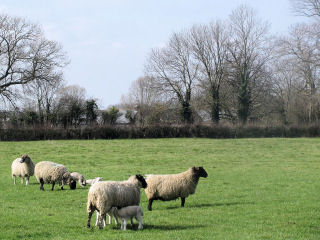

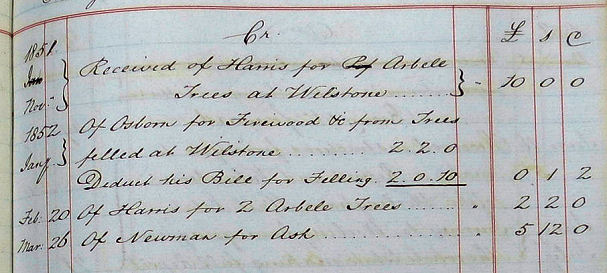


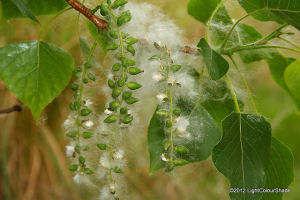
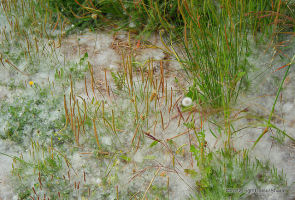

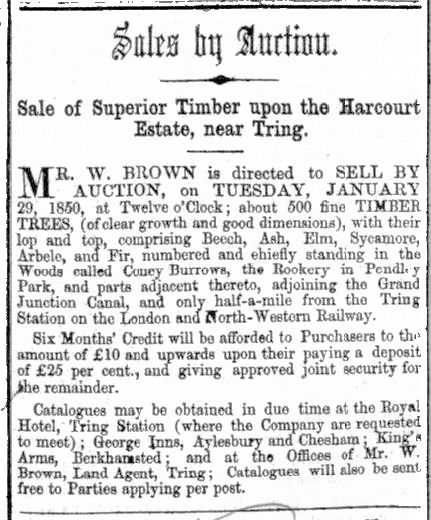 So
what was happening in the Tring area. In the
1851/2 entry William Brown had started to write "Poplar" and
then crossed it out and wrote "Arbele". In the later entry
he does not distinguish which species of poplar was being
felled. What we do know is that the accounts refer to the
felling of poplar trees in an area where a large number of
black poplars had been planted in the hedgerows, apparently
as a commercial crop. In both
cases William Brown travelled to Wilstone to check which
trees were being felled and in each case there appears to
have been a timber crop worth about £10 and "firewood" (presumably
"lop and top") worth between £1 and £2.
So
what was happening in the Tring area. In the
1851/2 entry William Brown had started to write "Poplar" and
then crossed it out and wrote "Arbele". In the later entry
he does not distinguish which species of poplar was being
felled. What we do know is that the accounts refer to the
felling of poplar trees in an area where a large number of
black poplars had been planted in the hedgerows, apparently
as a commercial crop. In both
cases William Brown travelled to Wilstone to check which
trees were being felled and in each case there appears to
have been a timber crop worth about £10 and "firewood" (presumably
"lop and top") worth between £1 and £2. 